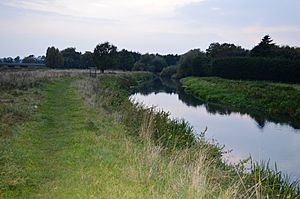The Riddy facts for kids

The Riddy is a special natural area near Sandy, Bedfordshire, in the United Kingdom. It's a large flood meadow (a field that sometimes floods) next to the River Ivel. This 8.4-hectare (about 20-acre) area is a Local Nature Reserve. It's owned by Sandy Town Council but looked after by two groups: the Wildlife Trust for Bedfordshire, Cambridgeshire and Northamptonshire and the Bedfordshire Rural Communities Charity. The Riddy gets its name from a small stream that flows through it. This place is home to many different plants and animals. You can find lots of grasses and flowers in the meadows. Water plants and water voles live in the ditches, ponds, and stream. Many birds also visit to find food.
The Riddy is open for everyone to visit. Some paths can be a bit bumpy, but the path along the river is easy to use. There's even a special gate for disabled access. If you want to fish in the River Ivel from The Riddy, you need a special permit from the town council and a national fishing license.
Contents
A Look Back: The Riddy's History
Long ago, many rivers had special meadows like The Riddy next to them. Sadly, most of these old meadows are now gone. The Riddy is one of the few that remain from that time.
Back in the 1200s, this area was called "Parkesriding." If you visit the north-eastern part of The Riddy, you might see a mill pool. A mill is a building that uses water power to grind grain. The last mill here was built in 1857, but we know that mills have been on The Riddy since at least Norman times, which was a very long time ago!
The Riddy: A Special Nature Reserve
The Riddy was officially named a Local Nature Reserve in 2006 by Sandy Town Council. It's known as an 'Urban Fringe' site, meaning it's a natural area close to a town. The Wildlife Trust for Bedfordshire, Cambridgeshire and Northamptonshire describes The Riddy as "an oasis of wild flowers, bird song and a wonderful view among a sea of arable fields." This means it's like a beautiful, wild island in an area mostly covered by farms.
Plants and Flowers at The Riddy
The meadows at The Riddy are full of different grasses and other plants. One special flower you might see is the cuckoo flower (Cardamine pratensis).
The ponds, stream, and ditches are home to many water plants. These include:
- Arrowhead (Sagittaria sagittifolia)
- Celery-leaved buttercup (Ranunculus sceleratus)
- Purple loosestrife (Lythrum salicaria)
- European water-plantain (Alisma plantago-aquatica)
- Duckweed
Animals Living in The Riddy
The stream at The Riddy is about 500 meters (or 500 yards) long. In this stream, you can find fish like chub (Squalius cephalus) and carp.
One very important animal living here is the water vole (Arvicola amphibius). These small, furry animals are protected by law in the United Kingdom.
Many different birds visit The Riddy. Some birds, like the redwing (Turdus iliacus), fieldfare (Turdus pilaris), and northern lapwing (Vanellus vanellus), feed in the meadows. You might also see sparrowhawks (Accipiter nisus) flying over the tall hedges, looking for food.
Other birds that hunt fish in the water include grey herons (Ardea cinerea) and common terns (Sterna hirundo). In the autumn, you might spot song thrushes (Turdus philomelos) at the reserve. Grey wagtails (Motacilla cinerea) and kingfishers (Alcedo atthis) have also been seen enjoying The Riddy.
How The Riddy is Looked After
The Riddy is managed by two groups: the Wildlife Trust for Bedfordshire, Cambridgeshire and Northamptonshire and the Bedfordshire Rural Communities Charity. They work together with a group of volunteers called 'Ivel Valley Conservation Volunteers'.
These groups do important jobs to keep The Riddy healthy:
- They practice coppicing on a small area of willow trees. This means cutting the trees back to the ground to encourage new growth.
- They use cattle to graze the meadows. This helps to remove the plants that grow each season and keeps the grassland habitats in good condition.
- They remove a plant called ragwort (Jacobaea vulgaris). Ragwort is poisonous to some animals, especially the grazing cattle, if they eat it. Removing it helps keep the cattle safe.

